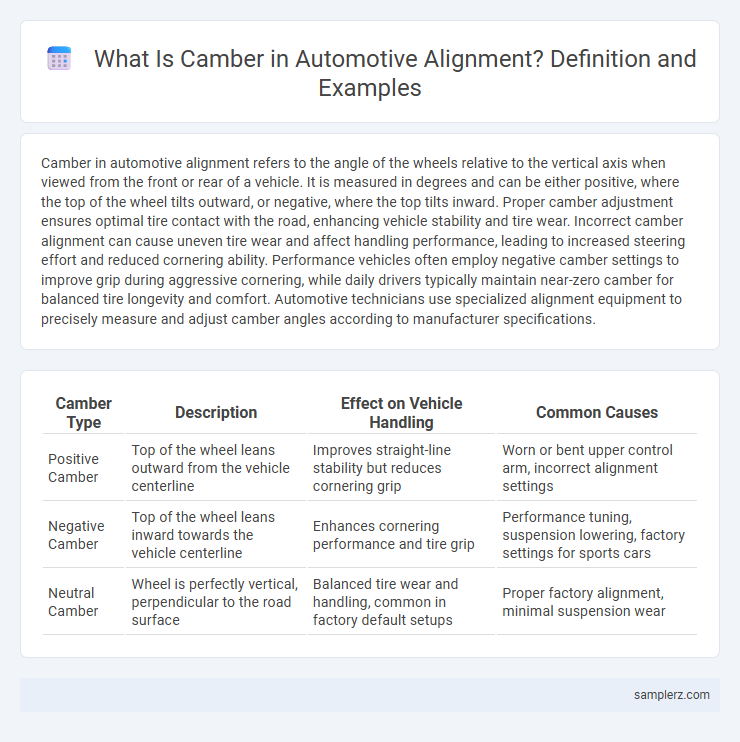Camber in automotive alignment refers to the angle of the wheels relative to the vertical axis when viewed from the front or rear of a vehicle. It is measured in degrees and can be either positive, where the top of the wheel tilts outward, or negative, where the top tilts inward. Proper camber adjustment ensures optimal tire contact with the road, enhancing vehicle stability and tire wear. Incorrect camber alignment can cause uneven tire wear and affect handling performance, leading to increased steering effort and reduced cornering ability. Performance vehicles often employ negative camber settings to improve grip during aggressive cornering, while daily drivers typically maintain near-zero camber for balanced tire longevity and comfort. Automotive technicians use specialized alignment equipment to precisely measure and adjust camber angles according to manufacturer specifications.
Table of Comparison
| Camber Type | Description | Effect on Vehicle Handling | Common Causes |
|---|---|---|---|
| Positive Camber | Top of the wheel leans outward from the vehicle centerline | Improves straight-line stability but reduces cornering grip | Worn or bent upper control arm, incorrect alignment settings |
| Negative Camber | Top of the wheel leans inward towards the vehicle centerline | Enhances cornering performance and tire grip | Performance tuning, suspension lowering, factory settings for sports cars |
| Neutral Camber | Wheel is perfectly vertical, perpendicular to the road surface | Balanced tire wear and handling, common in factory default setups | Proper factory alignment, minimal suspension wear |
Understanding Camber in Wheel Alignment
Camber in wheel alignment refers to the angle of the wheels relative to the vertical axis when viewed from the front or rear of a vehicle. Positive camber means the top of the wheel tilts outward, while negative camber tilts inward, affecting tire wear and handling performance. Proper camber adjustment enhances cornering stability, tire contact with the road, and overall vehicle safety.
Types of Camber: Positive vs. Negative
Positive camber occurs when the top of the wheels tilt outward from the vehicle, enhancing stability during straight-line driving and reducing tire wear on the inner edges. Negative camber features the top of the wheels leaning inward, improving cornering grip by increasing tire contact with the road during turns. Proper adjustment between positive and negative camber is crucial for optimal vehicle handling and tire longevity in automotive alignment.
Real-World Examples of Camber Adjustment
Camber adjustment in automotive alignment is critical for optimizing tire contact with the road, as seen in performance vehicles like the Subaru WRX, which often use negative camber to enhance cornering grip. Adjusting camber can correct uneven tire wear, a common issue in SUVs such as the Toyota RAV4, where positive camber is sometimes increased to improve stability. Real-world applications also include racing cars like the Formula 1 vehicles, where precise camber settings maximize traction and handling at high speeds.
Effects of Camber on Tire Wear
Excessive positive or negative camber angles cause uneven tire wear by increasing pressure on either the inner or outer edges of the tire tread. Negative camber improves cornering performance but accelerates inner edge wear, while positive camber results in outer edge wear and reduced handling stability. Proper camber alignment enhances tire longevity and overall vehicle safety by ensuring even tread contact with the road surface.
Camber Settings for Performance Vehicles
Performance vehicles often utilize aggressive negative camber settings, typically ranging from -2 to -4 degrees, to enhance cornering grip and stability at high speeds. Adjusting camber improves tire contact with the road during lateral loads, reducing understeer and increasing traction in sharp turns. Precise camber alignment balances tire wear and handling, crucial for maximizing performance on track or spirited driving conditions.
Everyday Driving: Camber Impact on Handling
Negative camber enhances cornering grip by tilting the tire inward at the top, improving handling during everyday driving. Proper camber settings balance tire wear and stability, ensuring safer and more responsive steering on various road conditions. Excessive camber can cause uneven tire wear, reducing overall tire lifespan and affecting vehicle performance.
Signs of Incorrect Camber Alignment
Uneven tire wear, especially more wear on one edge of the tire, signals incorrect camber alignment in vehicles. Drivers may experience poor handling, such as drifting or pulling to one side during driving, indicating camber issues. Steering wheel vibration and reduced tire lifespan further highlight the need for camber adjustment in automotive alignment maintenance.
Camber in Off-Road and Racing Applications
Camber in off-road and racing applications is crucial for optimizing tire contact with uneven terrain and high-speed cornering, respectively. Negative camber improves cornering grip by maximizing the tire's contact patch during aggressive turns, while a slight positive camber can help maintain stability on rugged off-road surfaces. Precision camber adjustments enhance vehicle handling, traction, and overall performance in challenging environments.
How to Measure and Adjust Camber
Camber in automotive alignment refers to the tilt of the wheels relative to the vertical axis when viewed from the front or rear of the vehicle. To measure camber, use a camber gauge or an alignment machine that provides precise angle readings, ensuring the vehicle is on a level surface for accurate results. Adjust camber by altering the upper or lower control arms, strut mounts, or camber bolts, depending on the vehicle's suspension design, to achieve manufacturer specifications and optimize tire contact and handling.
Camber Alignment: Maintenance Tips and Best Practices
Camber alignment affects tire wear and vehicle handling by adjusting the tilt of the wheels relative to the road. Regular inspection using a high-precision alignment machine ensures camber angles remain within manufacturer specifications to prevent uneven tire wear and improve stability. Maintenance practices include checking for suspension component wear and performing camber adjustments during routine wheel alignment services.

example of camber in alignment Infographic
 samplerz.com
samplerz.com